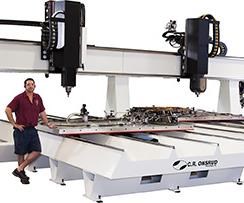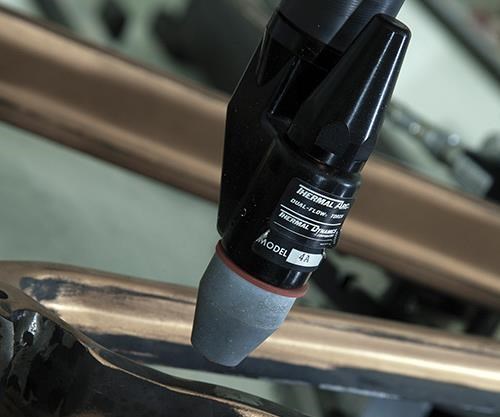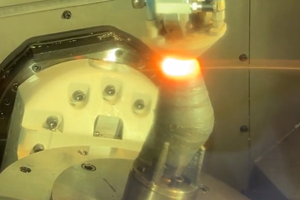How Steinway Machines Its Pianos
A custom-designed five-axis dual process CNC router allows a piano builder to machine a critical part more quickly, retaining the quality of tone for which it is known.
Share





According to Steinway & Sons, founded in New York City in 1853, its grand pianos are the choice of approximately 98 percent of concert pianists around the world due to their craftsmanship and quality of tone. A key to producing that tone is the piano’s high-tension plate—the harp-shaped, cast iron, internal structure across which strings are strung—which serves as the heart of a piano’s tone board.
Until recently, these plates were machined in Steinway’s manufacturing facility in Hamburg, Germany, but their range of sizes, weighing between 150 and 200 pounds each, presented particular challenges in terms of utilizing manual fixturing to accommodate machining on both sides. The company wanted to develop a more streamlined machining method, including integrating a heat-treat process that was currently being performed on secondary equipment. If this could be achieved, it hoped to bring this machining process back to the United States to its foundry location in Springfield, Ohio. This will reduce shipping costs, streamline production, and speed delivery to customers throughout North America.
To that end, Steinway approached C.R. Onsrud Inc. (CRO), a manufacturer of CNC routers and mills based in Troutman, North Carolina, to develop a custom machine to mitigate those production challenges. Efforts by the lead design engineer, Adam Hassler, and his team resulted in the F244E five-axis, dual-process router, a large, bridge-type machine featuring dual spindles and twin tables.
“Many times a ‘catalog’ machine will fit the bill for a specific manufacturing need of producing a part, but our application engineers work with our customers to create tailor-made solutions for our clients that also help streamline their machining processes,” says Matt Jenkins, CRO’s director of marketing. “The unique machine we created for Steinway has a number of key design elements that combine to more effectively machine the company’s plates.” These features include:
Sturdy base. CNC routers are commonly used to machine wood and non-ferrous metals such as aluminum. Because this machine would be milling cast iron, key structural components were designed in such a way as to provide the high rigidity needed to mill and drill this tougher material. The machine features three columns supporting the bridge, which spans the two tables. The welded steel frame provides a level of rigidity typically found in larger mills, and once anchored to the facility floor, the machine provides the stability and needed to meet the precision tolerances demanded by Steinway, Mr. Jenkins says.
Dual-spindle, dual-table design. The original mill used to machine plates featured a single spindle and single large table. After machining was completed on one side of the plate at one end of the table, it was flipped and fixtured on the other side of the table. This means machining could only be performed on one part at a time. Plus, operators couldn’t access/fixture a part on one side of the table while machining was being performed on the other side.
The custom machine engineered by CRO features two 10-by-10-foot tables: one to present parts to a three-axis spindle and the other to a five-axis spindle. Both spindles are designed and manufactured by German spindle-maker Kessler. Used for trimming, face milling and drilling operations on the bottom side of the plate, the three-axis spindle offers 15 kW and maximum rotational speed of 14,000 rpm, and is able to perform aggressive face milling operations for the keyboard surface, for example, at a spindle speed of 830 rpm and a feed rate of 400 ipm. After three-axis machining is completed, the part is flipped and delivered to the other table using an integral gantry crane, enabling five-axis work to be performed on the other side of the plate. The five-axis spindle, which offers 29 kW and 12,000-rpm rotation speed, is used for lighter machining of smaller features, and drilling and boring angular holes.
This two-spindle design enables concurrent machining on two parts. CRO also designed an enclosure around the machine to protect operators from flying chips and to contain them for easy cleanup. Two doors allow the tables to transition in and out of the workzone independently.
Hydraulic clamping. The previous fixturing system was manual and time-consuming, employing conventional screw-type clamps. The clamping system for the F244E is hydraulic and automated, using a timed sequence of clamp actuation to avoid distorting the plate. This way, plates can be fixtured in 5-10 minutes rather than hours. It also provides greater holding force on the plate, enabling more aggressive cuts to be performed.
One challenge in the development of this system was making sure it could accommodate 10 different part sizes. The resulting system can be reconfigured in seconds, allowing Steinway to manufacture its entire inventory of tone boards on the one machine with a minimum of additional jigs or fixtures. Not only does it simplify the manufacturing process, Mr. Jenkins says, but it continues to deliver the same exacting tolerances that customers expect from the piano maker.
Optimized programming strategies. Alternate programming techniques have been developed for the new machine and clamping configuration that enable Steinway to machine the outside profile of the piano tables, which it wasn’t able to accomplish on its previous machine. The automated clamping on the fixtures swings out of the way as the cutting tool gets near and moves back into holding position as the tool passes, allowing this profile cut to be made.
Integral hardening. Plate production requires a hardening process on the rib of the plate over which the piano’s strings will run. To eliminate the need to remove a plate from the F244E to enable it to be hardened on another piece of equipment, CRO attached a plasma welding unit to a linear slide on the three-axis spindle head. No welding is performed. Instead, the unit’s plasma arc performs the heat-treat process on the rib. An M code directs the spindle to move to the proper Z-axis position for this heat treating.
According to CRO, this integrated heat treating, in conjunction with the concurrent machining made possible with the dual-spindle/twin-table design and automatic hydraulic clamping, enables machining and hardening of each plate to be completed three times faster than Steinway’s previous machining methods.
Related Content
DN Solutions America Unveils Impressive Chicago Technical Center at IMTS 2024
New tech center is serving as a cutting-edge showroom and a technological hub for advanced machining applications.
Read MoreFryer Milling Machine Provides Fast Setup, Simple Programming
The MB-R toolroom bed mill is reportedly capable of single- or multi-part production with a 0.0002" accuracy.
Read MoreAdditive/Subtractive Hybrid CNC Machine Tools Continue to Make Gains (Includes Video)
The hybrid machine tool is an idea that continues to advance. Two important developments of recent years expand the possibilities for this platform.
Read More5 Tips for Running a Profitable Aerospace Shop
Aerospace machining is a demanding and competitive sector of manufacturing, but this shop demonstrates five ways to find aerospace success.
Read MoreRead Next
Building Out a Foundation for Student Machinists
Autodesk and Haas have teamed up to produce an introductory course for students that covers the basics of CAD, CAM and CNC while providing them with a portfolio part.
Read MoreRegistration Now Open for the Precision Machining Technology Show (PMTS) 2025
The precision machining industry’s premier event returns to Cleveland, OH, April 1-3.
Read MoreSetting Up the Building Blocks for a Digital Factory
Woodward Inc. spent over a year developing an API to connect machines to its digital factory. Caron Engineering’s MiConnect has cut most of this process while also granting the shop greater access to machine information.
Read More
























.jpg;maxWidth=300;quality=90)







